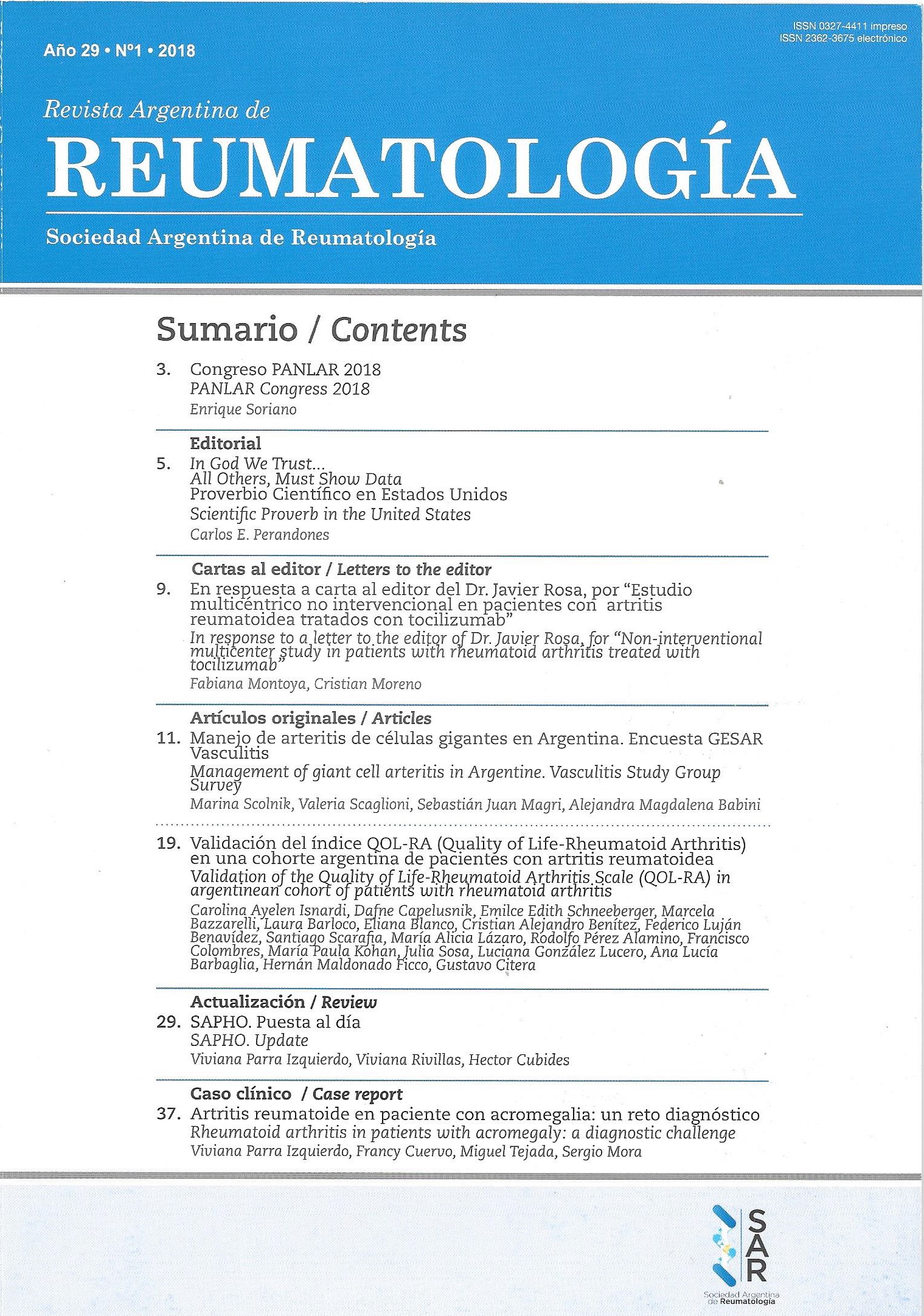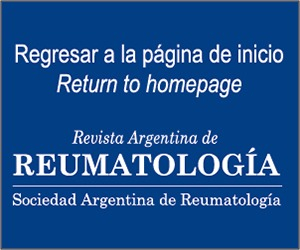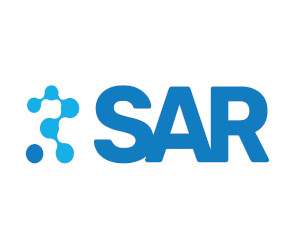Artritis reumatoide en paciente con acromegalia: un reto diagnóstico
Resumen
La acromegalia es una enfermedad crónica caracterizada por hipersecreción de la hormona del crecimiento (GH) y, en consecuencia, del factor de crecimiento similar a la insulina tipo 1 (IGF-1). Es frecuente el compromiso articular por acromegalia causando importante morbilidad y discapacidad funcional, dado que la hormona de crecimiento genera directamente destrucción del cartílago y cambios óseos. La asociación de acromegalia con artritis reumatoide es muy rara, siendo para el clínico un verdadero reto su diagnóstico temprano e intervención farmacológica agresiva para evitar secuelas irreversibles propias de la artritis reumatoide. Presentamos el caso de una paciente en la quinta década de la vida con acromegalia de 10 años de evolución, secundario a un adenoma hipofisario productor de hormona de crecimiento y diagnóstico de artritis reumatoide temprana.Citas
I. Chanson P, Salenave S, Kamenicky P, Cazabat L, Young J. Pituitary tumours: acromegaly. Best Pract Res Clin Endocrinol Metab. 2009;23(5):555-74.
II. Colao A, Marzullo P, Vallone G, Marino V, Annecchino M, Ferone D, et al. Reversibility of joint thickening in acromegalic patients: an ultrasonography study. J Clin Endocrinol Metab. 1998;83(6):2121-5.
III. Bluestone R, Bywaters EG, Hartog M, Holt PJ, Hyde S. Acromegalic arthropathy. Ann Rheum Dis. 1971;30(3):243-58.
IV. Melmed S. Medical progress: Acromegaly. N Engl J Med. 2006;355(24):2558-73.
V. Colao A, Ferone D, Marzullo P, Lombardi G. Systemic complications of acromegaly: epidemiology, pathogenesis, and management. Endocr Rev. 2004;25(1):102-52.
VI. Clayton RN. Cardiovascular function in acromegaly. Endocr Rev. 2003;24(3):272-7.
VII. Orme SM, McNally RJ, Cartwright RA, Belchetz PE. Mortality and cancer incidence in acromegaly: a retrospective cohort study. United Kingdom Acromegaly Study Group. J Clin Endocrinol Metab. 1998;83(8):2730-4.
VIII. Barkan AL. Acromegalic arthropathy. Pituitary. 2001;4(4):263-4.
IX. Barkan A. Acromegalic arthropathy and sleep apnea. J Endocrinol. 1997;155 Suppl 1:S41-4; discussion S5.
X. Dons RF, Rosselet P, Pastakia B, Doppman J, Gorden P. Arthropathy in acromegalic patients before and after treatment: a long-term follow-up study. Clin Endocrinol (Oxf). 1988;28(5):515-24.
XI. Killinger Z, Payer J, Lazurova I, Imrich R, Homerova Z, Kuzma M, et al. Arthropathy in acromegaly. Rheum Dis Clin North Am. 2010;36(4):713-20.
XII. Biermasz NR, Pereira AM, Smit JW, Romijn JA, Roelfsema F. Morbidity after long-term remission for acromegaly: persisting joint-related complaints cause reduced quality of life. J Clin Endocrinol Metab. 2005;90(5):2731-9.
XIII. Scarpa R, De Brasi D, Pivonello R, Marzullo P, Manguso F, Sodano A, et al. Acromegalic axial arthropathy: a clinical case-control study. J Clin Endocrinol Metab. 2004;89(2):598-603.
XIV. D etenbeck LC, Tressler HA, O'Duffy JD, Randall RV. Peripheral joint manifestations of acromegaly. Clin Orthop Relat Res. 1973(91):119-27.
XV. Colao A, Pivonello R, Scarpa R, Vallone G, Ruosi C, Lombardi G. The acromegalic arthropathy. J Endocrinol Invest. 2005;28(8 Suppl):24-31.
XVI. Jenkins PJ, Sohaib SA, Akker S, Phillips RR, Spillane K, Wass JA, et al. The pathology of median neuropathy in acromegaly. Ann Intern Med. 2000;133(3):197-201.
XVII. Lesse GP, Fraser WD, Farquharson R, Hipkin L, Vora JP. Gonadal status is an important determinant of bone density in acromegaly. Clin Endocrinol (Oxf). 1998;48(1):59-65.
XVIII. Mazziotti G, Bianchi A, Bonadonna S, Cimino V, Patelli I, Fusco A, et al. Prevalence of vertebral fractures in men with acromegaly. J Clin Endocrinol Metab. 2008;93(12):4649-55.
XIX. Giustina A, Mazziotti G, Canalis E. Growth hormone, insulin-like growth factors, and the skeleton. Endocr Rev. 2008;29(5):535-59.
XX. Genant HK, Wu CY, van Kuijk C, Nevitt MC. Vertebral fracture assessment using a semiquantitative technique. J Bone Miner Res. 1993;8(9):1137-48.
XXI. Ozcakar L, Akinci A, Bal S. A challenging case of rheumatoid arthritis in an acromegalic patient. Rheumatol Int. 2003;23(3):146-8.
XXII. Aydin Y, Coskun H, Kir S, Yazici S, Kudas O, Gungor A. Rheumatoid arthritis masquerading as acromegaly recurrence: report of two cases. Rheumatol Int. 2012;32(9):2913-5.
XXIII. Read RC, Watt I, Dieppe PA. Rheumatoid arthritis and acromegaly--effect of growth factors on RA? Br J Rheumatol. 1988;27(3):242-3.
XXIV. Miyoshi T, Otsuka F, Kawabata T, Inagaki K, Mukai T, Kawashima M, et al. Manifestation of rheumatoid arthritis after transsphenoidal surgery in a patient with acromegaly. Endocr J. 2006;53(5):621-5.
XXV. Podgorski M, Robinson B, Weissberger A, Stiel J, Wang S, Brooks PM. Articular manifestations of acromegaly. Aust N Z J Med. 1988;18(1):28-35.
XXVI. Oruk G, Tarhan F, Argin M, Ozmen M. Is every joint symptom related to acromegaly? Endocrine. 2013;43(2):404-11.
Derechos de autor 2018 Sociedad Argentina de Reumatología

Esta obra está bajo licencia internacional Creative Commons Reconocimiento-NoComercial-SinObrasDerivadas 4.0.






